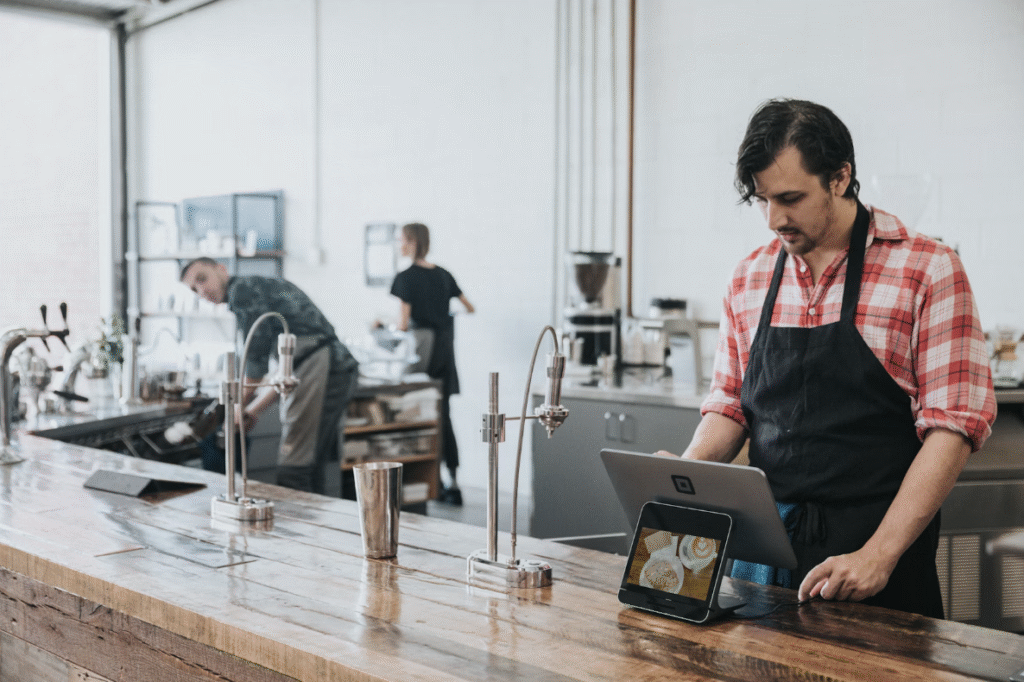Estimated Reading Time: 11 minutes

You’re running a loyalty program. Maybe you’ve sent out some marketing emails or SMS messages. But you have no idea who’s coming back, who redeemed their offer, or whether that campaign you ran did anything at all. And you’re left wondering how to increase repeat customers.
That’s where a restaurant CRM (Customer Relationship Management) comes in. By tracking your customers, you’re on the right track toward increasing repeat customers and profits.
Research shows that just a 5% boost in retention can increase your profits by 25-95%. That’s because repeat customers are loyal. And loyalty translates to spending more and bringing in more referrals.
In this article, I’ll break down what a restaurant CRM is (in plain English), how it works, why it matters, and when to invest.
What is a Restaurant CRM
A restaurant CRM tracks, understands, and connects with your customers all in one place. Unlike generic CRMs like HubSpot or Salesforce, they are built for B2B (business–to–business) sales teams.
A restaurant CRM is designed specifically for the hospitality industry. It is equipped with tools tailored for how restaurants interact with customers.
How Is It Different from HubSpot or Salesforce?
Traditional CRMs are great for managing leads, sales pipelines, and enterprise clients. But restaurants need something different:
- Instead of tracking deals, you’re tracking dining habits.
- Rather than sending sales quotes, you’re sending birthday rewards, re-engagement messages, and personalized offers.
- Instead of having sales reps, you have service teams that need quick insights about every customer.
What Can a Restaurant CRM Do?
A good restaurant CRM helps you:
- Build detailed customer profiles with names, birthdays, dietary preferences, order history, and more.
- Track visit frequency to identify loyal customers and win back ones who’ve gone silent.
- Segment your customers (first-timers, high-spenders, coffee lovers, etc.) to send highly targeted promos.
- Automate communication and rewards based on real customer behavior.
Why Not Just Use Spreadsheets or Punch Cards?
They work until they don’t. Once your customer list grows, manually tracking visits or spend is exhausting and overwhelming. Imagine looking at 1,000 rows of customer data in your spreadsheet.
Without smart automation or insights, you’re left guessing:
- Who are your VIPs?
- Who hasn’t visited in 30 days?
- Who should get a “We miss you” offer or early access to your next event?
How Restaurant CRMs Work
Track Guests Over Time (Not Just Per Visit)
A restaurant CRM connects the dots across your POS, online orders, reservations, and loyalty programs to give you a full picture of each guest.
You’ll see how often they visit, what they spend, and when they last came in—so you can spot regulars, identify lapsed guests, and tailor your outreach.
Segment and Target Guests Based on Behavior
Your customers love personalized offers and hate generic ones. So you shouldn’t blast the same offers to everyone. A study by Attentive reports:
- The majority of customers (71%) get frustrated by irrelevant messages.
- 8 in 10 ignore them completely.
- And 1 in 4 are less likely to buy after seeing a generic marketing message.
With a restaurant CRM, you can get clean and centralized data. This helps you easily identify VIPs, first-timers, those who haven’t ordered in more than 30 days, birthday diners, etc.
Also, a restaurant CRM can help you send “We miss you” emails, birthday texts, or loyalty milestone rewards automatically using built-in or third-party automation.
And this matters a lot! The majority of customers, roughly 8 out of 10, say being treated like a person and not a number is very important to win and retain their business. And the vast majority of business leaders say consumers spend more (34% more on average) when their experience is personalized.
Power Email & SMS Marketing
A restaurant CRM makes it easy to send personalized offers. You can link it with tools like Mailchimp or SimpleLoyalty to deliver timely, targeted messages to your customers.
Speaking of targeted messages, SMS marketing is one of the most powerful and low-competition channels for restaurants. Check out our Does SMS Marketing Really Work for Restaurants in 2025? article for stats and real-world case studies.
Improve Loyalty Program ROI
With real, clean and structured data, you can:
- Compare loyalty members vs. non-members to see who spends more and visits more often
- Track members’ behavior before and after reward redemptions to measure impact
- Spot key patterns, like “3 visits in 10 days” versus “10 visits in 6 months”
- Trigger milestone rewards or send a special “new regular” bonus to guests on the verge of becoming loyal
Restaurant CRM Examples
SimpleLoyalty
SimpleLoyalty lets restaurants like yours easily create a free loyalty program complete with a CRM without any coding. It simplifies point collection for your customers—no forms, cards, QR codes, or apps needed—just phone numbers.
So, while other CRMs focus on email marketing, SimpleLoyalty focuses on SMS marketing to help restaurants increase customer engagement and revenue.
Lightspeed
Lightspeed is a POS system with built-in CRM features. It tracks guest behavior like order history and visit frequency. These insights help with marketing and service improvements but loyalty features are limited and not the main focus.
Toast
Toast is a restaurant POS system with CRM features built in. It tracks guest data from orders, online bookings, and email sign-ups, then helps restaurants send targeted promotions. Toast also offers a separate loyalty add-on, but it’s not built into the CRM by default.
So, while Toast is useful for restaurants already using the Toast POS, it’s not a loyalty + CRM solution out of the box.
Restaurant CRM Benefits
Boost customer retention and repeat visits
One of the biggest challenges in the F&B industry is that 7 out of 10 customers never return after their first visit.
There are many reasons customers don’t return. And one of them is not being able to get to the top of their mind.
A restaurant CRM changes that. It helps you:
- Track visit frequency
- Identify lapsed guests
- Re-engage them automatically with timely offers, messages, or loyalty nudges
And it works! Restaurants using a dedicated CRM system typically see a 20% increase in repeat business within just six months of implementation.
Improve ROI from personalized email/SMS campaigns
Generic blasts get ignored. If you’re still sending the same message to everyone, you’re leaving money on the table. Because personalized messages (ones tailored with the recipient’s name, behavior, or interests) lead to more purchases or actions compared to generic, non-personalized emails.
A restaurant CRM helps you send the right message to the right guest at the right time, whether it’s a birthday offer, a “we miss you” text, or a lunch deal for your lunch regulars.
Save time through automation
You don’t need to spend hours crafting one-off emails or tracking guest behavior manually. With a restaurant CRM, you can automate your messages and tracking.
Just set it and let it run in the background 24/7.
On average, marketing automation helps businesses drive sales up to a 14.5% increase and a reduction in operating costs.
To learn more about the benefits of automation, check out our Restaurant Marketing Automation: Is It Worth It? article.
Turn customer data into sales
A restaurant CRM transforms raw transaction data into actionable insights. You’ll see things like:
- Which guest segments drive the most revenue
- Which campaigns actually convert
- Where to focus your time and budget for the biggest impact
The payoff is big as McKinsey reports that personalization can deliver five to eight times the ROI on marketing spend and boost sales by 10% or more.
When Should You Invest in a Restaurant CRM?
You’re expanding into multiple locations
As you scale to two, three, or more locations, tracking guest behavior gets harder. A restaurant CRM gives you a centralized view of each guest’s visits, preferences, and order history, no matter which location they dined at.
You don’t know who your top 100 customers are
Hidden among your customers are likely superfans. They are loyal guests who quietly drive a big chunk of your revenue.
According to the Pareto Principle, 80% of restaurant sales come from just 20% of repeat customers. Without a CRM, it’s nearly impossible to spot them.
So, a CRM makes it easy to identify your top spenders, understand their habits, and keep them coming back with personalized perks they’ll actually care about.
Email blasts feel like shouting into the void
General marketing often gets ignored. It risks spam complaints and unsubscribes which could damage your brand’s reputation and reach.
So, stop shouting into the void. Use a restaurant CRM to start speaking directly to the people who want to hear from you.
You’re discounting without targeting
Ever feel like discounts are hurting more than helping? That’s usually because they’re handed out randomly to everyone—without strategy.
A CRM changes that. It helps you target the right customers so every reward is tied to a purpose.
You want to track guest journeys over time
Understanding how a customer goes from a first-timer to a loyal regular is nearly impossible without a centralized system.
A restaurant CRM gives you that visibility to track each customer’s journey across visits, orders, and interactions. You’ll know who’s new, who’s becoming a regular, and who’s due for a little extra love.
Is a Restaurant CRM Worth It?
CRM is one of the highest ROI tech investments available. If you’re debating whether a CRM is just another flashy tool or a real driver of growth for your café, the data says it all.
- Across industries, businesses see an average $8.71 return for every $1 spent on CRM tools.
- Companies that use CRM software can see sales increase by up to 29%.
- Only 28% of customers visit more than once in six months. This means most customers only visit once in six months.
- With a dedicated restaurant CRM, you can improve that because even a modest 5% increase in customer retention (28% to 32%) can drive profit growth of 25% to 95%.
Why Restaurant CRMs Fail
Even the best CRM software can fall flat without the right execution. Here are the most common reasons they fail:
Lack of staff adoption & training
If your team doesn’t understand the CRM or finds it too hard to use, they’ll just ignore it. In busy restaurants, tools need to be easy to use and fit smoothly with the workflow.
Servers, baristas, and hosts are the ones who enter customer info into the system. If they’re not trained, the CRM stays empty and useless.
Poor data quality & dirty customer lists
The work doesn’t end when the customers enter their info. You need to clean them, as outdated information, duplicates, inconsistent formatting, missing data, incorrect segmentation, bounced emails and spam traps can kill CRM performance
One restaurant found that only 2 out of 10 emails reached customers’ inboxes. After cleaning up the list, 9 or 10 emails got through—and that brought in an extra £200,000 in sales.
No clear goals or strategy
Some restaurants get a CRM without a real plan. They don’t know what they want to improve. That means the teams also don’t know what to prioritize.
CRMs are just tools—they won’t magically fix your business.
Choosing the wrong restaurant CRM
Not every CRM is made for restaurants. Some, like Salesforce or HubSpot, are built for other industries. They may not work well with your POS (Point of Sale) system or booking tools.
Low guest engagement with loyalty/CRM features
Even with a CRM, many restaurants have more than 50% inactive loyalty program members. This drop-off is probably due to a lack of personalization, weak incentives, or clunky loyalty program app interfaces.
Restaurant CRM FAQs: What Businesses Ask Most
Do I need a CRM if I already have a POS (Point of Sale) system?
This is the most common misconception. Many restaurant owners think a POS system is enough. Most POS systems capture transactions, not relationships. A restaurant CRM helps you actually understand, segment, and communicate with your customers. Happy customers turn into loyal ones.
What if I try a restaurant CRM and no one engages?
That usually means your messages are too generic or your loyalty program is too clunky. The fix? Personalization and frictionless rewards. When loyalty feels easy, people respond.
Conclusion
A restaurant CRM can be a game-changer for cafes and restaurants that want to grow. But not all restaurant CRMs are built with restaurants in mind.
That’s where SimpleLoyalty stands out. It combines an easy-to-use CRM with a loyalty program your customers will actually enjoy. No apps, no QR codes, just phone numbers.
Ready to increase your repeat customers and see what’s working? Visit https://simpleloyalty.com/#/plans to get started or contact us at info@simpleloyalty.com.
The tools are there. Now it’s your move.


